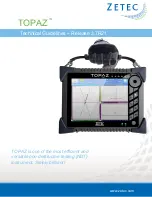
9-067
TROUBLESHOOTING
3. HYDRAULIC SYSTEM TROUBLESHOOTING
3-1. When Performing Hydraulic System Troubleshooting
The largest factor in the majority of failures of hydraulic devices operating under conditions of higher pressure and
greater precision is the entry of dirt (foreign substances) into the hydraulic circuit. Particular caution is required
when supplying hydraulic oil or when disassembling and assembling hydraulic devices.
1) Pay attention to the work environment.
As much as possible, avoid performing tasks such as supplying hydraulic oil, replacing filters and repair work
on rainy days, when there is strong wind, or in locations where there is much dust.
2) Disassembly and maintenance work in the field
There is the danger of dust entry when disassembly and maintenance work for hydraulic components is
performed in the field. In addition, because performance verification after repairs are completed is difficult,
replacement of the entire assembly is preferred. Perform disassembly and maintenance of hydraulic
components in a special room protected from dust, and use special testers to verify the performance.
3) Sealing of openings
Use caps, tape, plastic bags or other means to seal the openings of removed pipes and components in order
to prevent foreign substances from entering. Never leave the openings exposed or put a shop cloth into them.
There is the danger of foreign substances entering or of leaking oil causing environmental contamination.
Do not dispose of waste oil on-site. Either deliver it to the customer and request disposal or take it back with
you and dispose of it.
4) Prevent entry of foreign substances when supplying oil.
Take care that foreign substances do not enter when supplying hydraulic oil. Clean the oil supply port and
the area around it, as well as the supply pump, oilcan and other items. A more reliable method is to use oil
cleaning equipment, which can filter out the contamination that occurred during storage.
5) Change hydraulic oil while the temperature is still high.
All oils, including hydraulic oil, flow more readily when they are warm. Higher temperatures also make it
easier to eject the sludge and other substances outside the circuit together with the oil. For these reasons, oil
changes should be performed while the oil temperature is high. When changing the oil, it is necessary to drain
out as much of the old hydraulic oil as possible. (In addition to the hydraulic oil tank, also drain the oil from the
filter and circuit drain plugs.) If old hydraulic oil remains in the system, the contaminants and sludge in the old
oil will mix with the new oil and shorten the hydraulic oil lifetime.
•
Содержание SV414
Страница 1: ...SV414 SHOP MANUAL 3498 64214 0 ...
Страница 2: ......
Страница 4: ......
Страница 12: ......
Страница 13: ...SAFETY ...
Страница 14: ......
Страница 22: ......
Страница 23: ...SPECIFICATIONS ...
Страница 24: ......
Страница 25: ......
Страница 37: ...ENGINE AND CONTROLS ...
Страница 38: ......
Страница 45: ...HYDRAULIC SYSTEMS ...
Страница 46: ......
Страница 47: ......
Страница 50: ......
Страница 52: ......
Страница 54: ......
Страница 56: ......
Страница 57: ......
Страница 66: ......
Страница 74: ......
Страница 76: ......
Страница 80: ......
Страница 82: ......
Страница 85: ......
Страница 92: ......
Страница 93: ...ELECTRICAL SYSTEM ...
Страница 94: ......
Страница 98: ......
Страница 100: ......
Страница 126: ......
Страница 127: ...VIBRATORY DRUM REAR AXLE ...
Страница 128: ......
Страница 136: ......
Страница 168: ......
Страница 174: ......
Страница 175: ...BRAKE ...
Страница 176: ......
Страница 178: ......
Страница 180: ......
Страница 184: ......
Страница 185: ...INSPECTION AND ADJUSTMENT ...
Страница 186: ......
Страница 212: ......
Страница 213: ...TROUBLESHOOTING ...
Страница 214: ......
Страница 235: ......
Страница 292: ......
Страница 293: ......













































